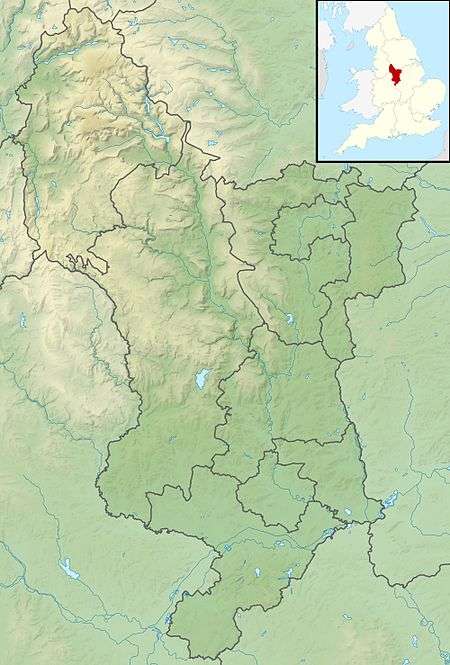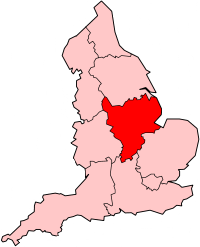Drakelow Power Station
| Drakelow Power Station | |
|---|---|
 Drakelow C Power Station in 2002 | |
 Location of Drakelow Power Station in Derbyshire | |
| Country | England |
| Location | Derbyshire, East Midlands |
| Coordinates | 52°46′25″N 1°39′24″W / 52.773608°N 1.656805°WCoordinates: 52°46′25″N 1°39′24″W / 52.773608°N 1.656805°W |
| Commission date | 1955 |
| Decommission date | 2003 |
| Operator(s) |
CEGB Powergen E.ON UK |
| Thermal power station | |
| Primary fuel | Coal-fired |
| grid reference SK231196 | |
Drakelow Power Station refers to a series of three now demolished coal-fired power stations located 2.4 mi (3.9 km) south of Burton upon Trent, Staffordshire in the West Midlands of England, on the River Trent. However, the station was actually located in the county of Derbyshire, in the East Midlands. The power station was a distinguishable landmark of Burton, which is most famous for its breweries.
History
Pre-Construction

The Drakelow power stations were built on the site of Drakelow Hall, a stately home on the south bank of the River Trent. Twenty eight generations of the Gresley family had considered the estate as nothing more than their ancestral home. It had appeared in the Domesday Book and the family could trace its history back to the time of the Norse Vikings. A book that was published in 1899, "The Gresleys of Drakelowe", is the accepted history of the family. The hall was demolished in 1934 and its site then earmarked for development in the early 1940s.[1] The remains of the Elizabethan hall occupied part of the site even after the power station was built. The site was chosen for the construction of a power station because it was around 750 acres (3.0 km2) in size and was within close proximity to the River Trent as well as the main Leicester to Burton railway to the north, the Burton to Tamworth road to the south-east, and was close to the East Midlands coalfields.[1]
Construction
By the 1940s, the estate was no longer owned by the Gresley family, but by Sir Clifford Gothard. The sale of the land was agreed for a three phase development of electricity generation on the site. Planning permission for the construction of the station was granted in March 1950.[2] The £23 Million project was considered a great technological advancement in its day. Rapid progress was being made with the development of larger boilers and generator units. Drakelow A Power Station was commissioned in 1955 and had a capacity of 240 megawatts (MW). By the time of its opening, work had already started on its larger 480 MW sister, Drakelow B Power Station.[3] It used four 120 MW units and was commissioned between 1959 and 1960.[4] Both the A and B stations were brick built. The A station had two chimneys each at 360 ft high. B station also had two chimneys (slightly taller) at 400 ft high. They were cooled by four cooling towers each 300 ft high.
The third, final and largest stage of the build was then underway with the construction of Drakelow C Power Station. Work began in 1962 and took two years to complete, beginning generating in 1964.[5] With six larger, 360 ft (110 m) cooling towers, two 168 m (551 ft) chimneys and two 350MW and two 375MW generators, it dwarfed both the A and B stations put together, having a generating capacity of 1450 MW.[5][6] This gave the site a total generation capacity of 2170 MW over the three stations, making it the largest electricity generation site in the Europe for a time.[5]

Operations
The Drakelow power stations had a workforce of hundreds of people. The station had its own Football, Cricket and Rugby clubs and became part of the community by holding various charity events. Drakelow also proudly boasted a clean accident record. A popular nature trail was housed within the station's grounds.
The station itself did suffer one or two events in its time. A minor fire broke out at the station in the early 1980s and part of C Station was flooded when the River Trent burst its banks in 2000. Overall however, the station flowed through a rather seamless life.
The Drakelow site's ownership changed hands on several occasions. It was sold to TXU, an American company, and then in the early 1990s, to Powergen. Powergen were then bought out by E.ON UK in 2001.
Closure and demolition
The A station closed in 1984, and the B station closed in 1993 after surpassing its designed life expectancy.[7] The cooling towers were demolished on 20 December 1998, and by this time the four chimneys and main buildings had also been demolished, leaving only the C Station operating.[2]
One of the station's generating sets was taken out of operation in 1995, reducing the stations capacity by 333 MW.[4] There had been talk about the closure of Drakelow C Power Station since late 2002, but E.ON denied the rumours. However, in January 2003, E.ON announced that the station was to close, and on 31 March 2003, the station was decommissioned.[5] It was mothballed soon after and left standing until October 2005. At 05.00 a.m. on 17 November 2005, the two tall chimneys were demolished. By April 2006, the two 170 ft (52 m) tall boiler houses had been stripped down to their steel frames, which were demolished at 10.00 a.m. on 27 April 2006.[8]
The six remaining cooling towers were scheduled to be demolished 11.00 p.m. on 19 July 2006.[5] However, the six towers remained standing past their blow down time as a fault with the detonator was found. This was a disappointment for the thousands of spectators which had gathered to see the demolition. A new date for the demolition was set for 20 September 2006 at 10.00 p.m., when the towers finally came down - but again, not without fault. One set of towers came down at 10.00 p.m., but the other three failed after rabbits had chewed through the detonation cord. However at 10.50 p.m. the final set of towers came crashing down, ending the era of Drakelow Power Station.
Future plans
In September 2005, E.ON applied for government permission to build a 1,220 MW CCGT gas-fired power station on the site of the coal-fired stations. It would cost £350 million to construct and would consist of three generating units.[9] On 16 October 2007, Section 36 consent was granted to allow for the construction of the new station. They had planned for construction to begin in 2008, with the goal of having the plant operational by early 2011. Work on these power stations has not yet begun.[10] There are also plans to build a biomass-fired power station on the site. Plans have been put in for 2200 homes to be built on the site and at the same time e-on put in plans to double the size of the plant and now will power 2 million homes. If the plans are accepted it would be up and running by 2017.[11]
References
- 1 2 "Site History". http://www.drakelowpark.com/. Retrieved 2008-12-14. External link in
|work=(help) - 1 2 "Proposed Landfilling of Asbestos Waste Arising from the Demolition of Drakelow Power Station, off Walton Road, Drakelow" (PDF). https://www.derbyshire.gov.uk/. 11 April 2005. Retrieved 2008-12-14. External link in
|work=(help) - ↑ James, Malcolm. "Model of Drakelow "A" Power Station" (DOC). http://www2.theiet.org/. Retrieved 2008-12-14. External link in
|work=(help) - 1 2 "Generation disconnections since 1991". http://www.nationalgrid.com/. 2003. Retrieved 5 October 2009. External link in
|work=(help) - 1 2 3 4 5 "E.ON UK's Drakelow C Power Station's cooling towers to be demolished under cover of darkness" (ASPX). http://pressreleases.eon-uk.com/. 4 July 2006. Retrieved 2008-12-14. External link in
|work=(help) - ↑ "Air Quality Review and Assessment for South Derbyshire" (PDF). http://www.south-derbys.gov.uk/. August 2000. p. 13. Retrieved 2008-11-27. External link in
|work=(help) - ↑ "Drakelow B Last Shutdown". http://www.powerstationsrevisited.org.uk/. Archived from the original on 24 October 2007. Retrieved 2008-12-14. External link in
|work=(help) - ↑ "E.ON UK's Drakelow C Power Station's boiler houses to be demolished" (ASPX). http://pressreleases.eon-uk.com/. 20 April 2006. Retrieved 2008-12-14. External link in
|work=(help) - ↑ "1,220 MW gas station planned for Drakelow" (PHP). http://www.ndtcabin.com/. 9 September 2005. Retrieved 2008-12-14. External link in
|work=(help) - ↑ "TABLE OF POTENTIAL NEW CONVENTIONAL ELECTRICITY GENERATING PLANTS IN GREAT BRITAIN NOVEMBER 2007" (PDF). BERR. Retrieved 2008-03-01.
- ↑ "MP backs mooted biomass power station for South Derbyshire". http://www.thisisderbyshire.co.uk/. 17 November 2008. Retrieved 2008-12-14. External link in
|work=(help)
External links
| Wikimedia Commons has media related to Drakelow Power Station. |
- Drakelow Cooling Towers after Demolition
- 'Power Stations Revisited' webpage on Drakelow Power Station
- Slow motion video of cooling tower demolition on YouTube
- Demolition of turbine hall on YouTube
- Demolition of boiler house on YouTube
- Another video of the cooling tower demolition
| Preceded by Barking Power Station |
Largest Power Station in the UK 1962-1966 |
Succeeded by Blyth Power Station |
